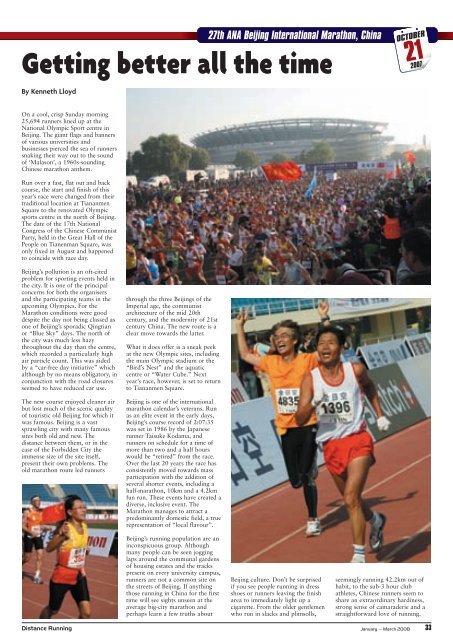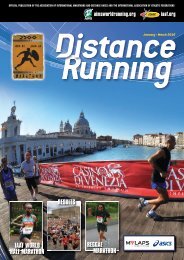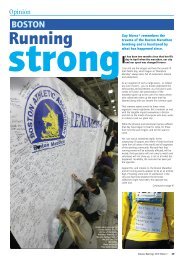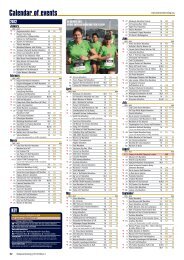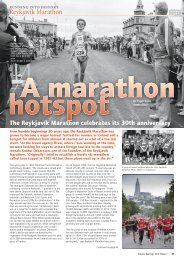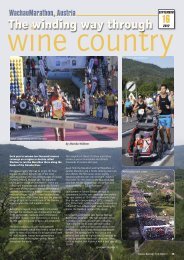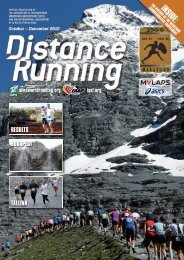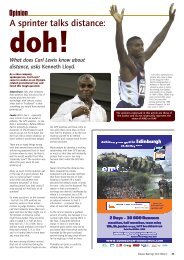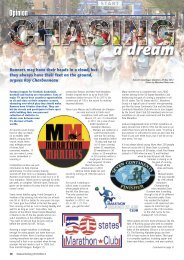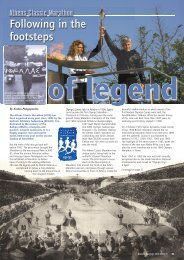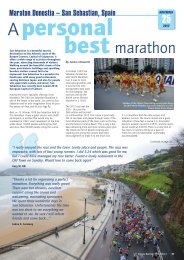Download pdf - Distance Running magazine
Download pdf - Distance Running magazine
Download pdf - Distance Running magazine
Create successful ePaper yourself
Turn your PDF publications into a flip-book with our unique Google optimized e-Paper software.
27th ANA Beijing International Marathon, China<br />
Getting better all the time<br />
OCTOBER<br />
21<br />
2007<br />
By Kenneth Lloyd<br />
On a cool, crisp Sunday morning<br />
25,694 runners lined up at the<br />
National Olympic Sport centre in<br />
Beijing. The giant flags and banners<br />
of various universities and<br />
businesses pierced the sea of runners<br />
snaking their way out to the sound<br />
of ‘Malason’, a 1960s-sounding<br />
Chinese marathon anthem.<br />
Run over a fast, flat out and back<br />
course, the start and finish of this<br />
year’s race were changed from their<br />
traditional location at Tiananmen<br />
Square to the renovated Olympic<br />
sports centre in the north of Beijing.<br />
The date of the 17th National<br />
Congress of the Chinese Communist<br />
Party, held in the Great Hall of the<br />
People on Tianenman Square, was<br />
only fixed in August and happened<br />
to coincide with race day.<br />
Beijing’s pollution is an oft-cited<br />
problem for sporting events held in<br />
the city. It is one of the principal<br />
concerns for both the organisers<br />
and the participating teams in the<br />
upcoming Olympics. For the<br />
Marathon conditions were good<br />
despite the day not being classed as<br />
one of Beijing’s sporadic Qingtian<br />
or “Blue Sky” days. The north of<br />
the city was much less hazy<br />
throughout the day than the centre,<br />
which recorded a particularly high<br />
air particle count. This was aided<br />
by a “car-free day initiative” which<br />
although by no means obligatory, in<br />
conjunction with the road closures<br />
seemed to have reduced car use.<br />
The new course enjoyed cleaner air<br />
but lost much of the scenic quality<br />
of touristic old Beijing for which it<br />
was famous. Beijing is a vast<br />
sprawling city with many famous<br />
sites both old and new. The<br />
distance between them, or in the<br />
case of the Forbidden City the<br />
immense size of the site itself,<br />
present their own problems. The<br />
old marathon route led runners<br />
through the three Beijings of the<br />
Imperial age, the communist<br />
architecture of the mid 20th<br />
century, and the modernity of 21st<br />
century China. The new route is a<br />
clear move towards the latter.<br />
What it does offer is a sneak peek<br />
at the new Olympic sites, including<br />
the main Olympic stadium or the<br />
“Bird’s Nest” and the aquatic<br />
centre or “Water Cube.” Next<br />
year’s race, however, is set to return<br />
to Tiananmen Square.<br />
Beijing is one of the international<br />
marathon calendar’s veterans. Run<br />
as an elite event in the early days,<br />
Beijing’s course record of 2:07:35<br />
was set in 1986 by the Japanese<br />
runner Taisuke Kodama, and<br />
runners on schedule for a time of<br />
more than two and a half hours<br />
would be “retired” from the race.<br />
Over the last 20 years the race has<br />
consistently moved towards mass<br />
participation with the addition of<br />
several shorter events, including a<br />
half-marathon, 10km and a 4.2km<br />
fun run. These events have created a<br />
diverse, inclusive event. The<br />
Marathon manages to attract a<br />
predominantly domestic field, a true<br />
representation of “local flavour”.<br />
Beijing’s running population are an<br />
inconspicuous group. Although<br />
many people can be seen jogging<br />
laps around the communal gardens<br />
of housing estates and the tracks<br />
present on every university campus,<br />
runners are not a common site on<br />
the streets of Beijing. If anything<br />
those running in China for the first<br />
time will see sights unseen at the<br />
average big-city marathon and<br />
perhaps learn a few truths about<br />
Beijing culture. Don’t be surprised<br />
if you see people running in dress<br />
shoes or runners leaving the finish<br />
area to immediately light up a<br />
cigarette. From the older gentlemen<br />
who run in slacks and plimsolls,<br />
seemingly running 42.2km out of<br />
habit, to the sub-3 hour club<br />
athletes, Chinese runners seem to<br />
share an extraordinary hardiness,<br />
strong sense of camaraderie and a<br />
straightforward love of running.<br />
<strong>Distance</strong> <strong>Running</strong> January – March 2008<br />
33


